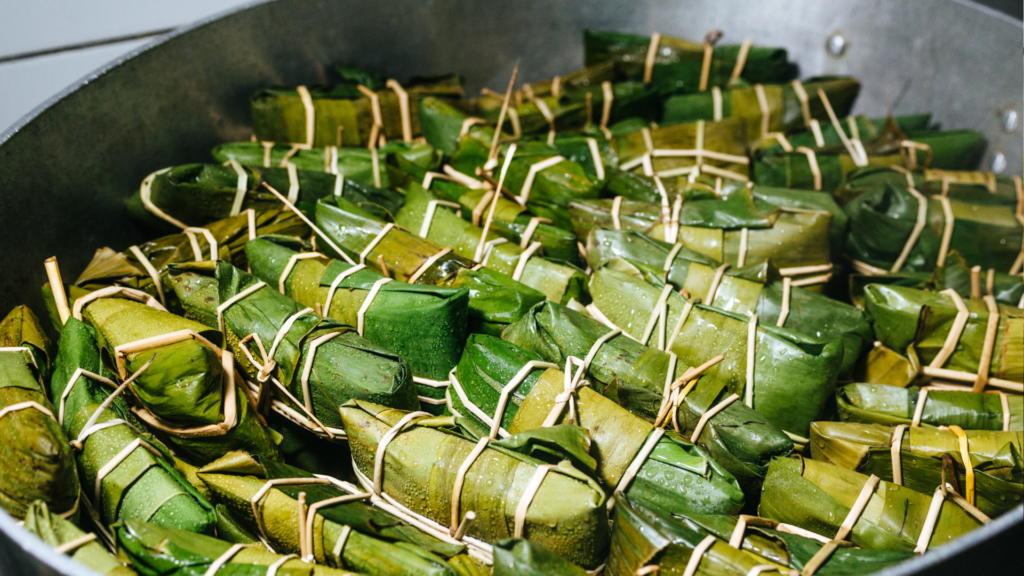Tamales are a traditionally significant dish in Central America during the holiday season, especially during Christmas and New Year’s. They are often prepared and shared with family or friends to celebrate these special occasions.
Why are tamales so important during this gathering period?
Cultural Tradition: Tamales have a long history in Central America, dating back to pre-Columbian civilizations, and they have become a symbol of the region’s culture and identity. Their preparation and sharing during the holidays strengthen cultural and family ties.
Family Gathering: The preparation of tamales is often a group activity that brings the family together. Family members gather to prepare the corn dough, the filling, and wrap the tamales in corn or banana leaves, fostering camaraderie and strengthening family bonds.
Variety of Flavors: Tamales can be prepared with a wide variety of fillings, including meat (such as pork, beef, chicken), vegetables, chilies, cheeses, and even fruits. This diversity allows each family to customize their tamales according to their culinary preferences.
Sharing and Generosity: Tamales are often prepared in large quantities, allowing families to share this dish with their neighbors, friends, and loved ones. It is a way to show generosity and hospitality during the holiday season.
Religious Celebration: In Central America, the Christmas period is often associated with religious celebrations. Tamales may be served after the midnight mass or during other religious ceremonies, further emphasizing their importance in local religious traditions.
Symbol of Abundance: Tamales are often considered a festive and luxurious dish due to the labor required to prepare them. Their presence on the holiday table symbolizes abundance and prosperity for the coming year.

The preparation of this popular traditional dish
Corn Dough Preparation: To prepare the corn dough, a mixture of corn flour, fat (such as pork fat or vegetable fat), meat or vegetable broth, baking powder, salt, and sometimes spices is combined. The dough should have a soft but not too liquid consistency.
Filling Preparation: Traditional tamales fillings can vary depending on the region. Cooked and shredded meat (such as pork, beef, or chicken), cheese, cooked vegetables, chilies, olives, raisins, or other ingredients can be used according to local preferences.
Assembly of Tamales: For each tamal, a small amount of corn dough is spread onto a corn or banana leaf that has been soaked in hot water to soften it. Then, a portion of filling is added to the center of the dough. The leaf is then folded to wrap the filling, creating a small rectangular package. It can be tied with string or additional corn leaves.
Steaming: Tamales are steamed in a large pot called a « tamalera » for about an hour or more, until they are well-cooked and the dough has hardened.
Serving: Tamales are typically served hot and can be accompanied by various sauces, sour cream, Lizano sauce in Costa Rica, or guacamole in Mexico and elsewhere.
Tamales are a culinary specialty enjoyed on many special occasions, including year-end holidays, weddings, birthdays, and other family celebrations. They are also sold in many Latin American markets and restaurants and are appreciated for their delicious taste and versatility in fillings.
In summary, tamales hold a special place in Central American culture during the holiday season due to their history, role in family gatherings, diversity of flavors, symbolism, and importance in local religious traditions. They are an emblematic food that helps make this time of year even more meaningful and memorable for the region’s residents.
¡BUEN PROVECHO!


- A Small Nation, a Great Talent: The Story of Luis Castillo-Briceño
- Voyager en sécurité : votre guide essentiel au Costa Rica
- Enhanced Safety in Costa Rica: A New 9-1-1 Center Dedicated to Tourists
- Sécurité renforcée au Costa Rica : un nouveau centre 9-1-1 au service des touristes
- Le costaricien Luis Castillo Briceño, nous parle de son triomphe à la compétition internationale des chefs d’orchestre


